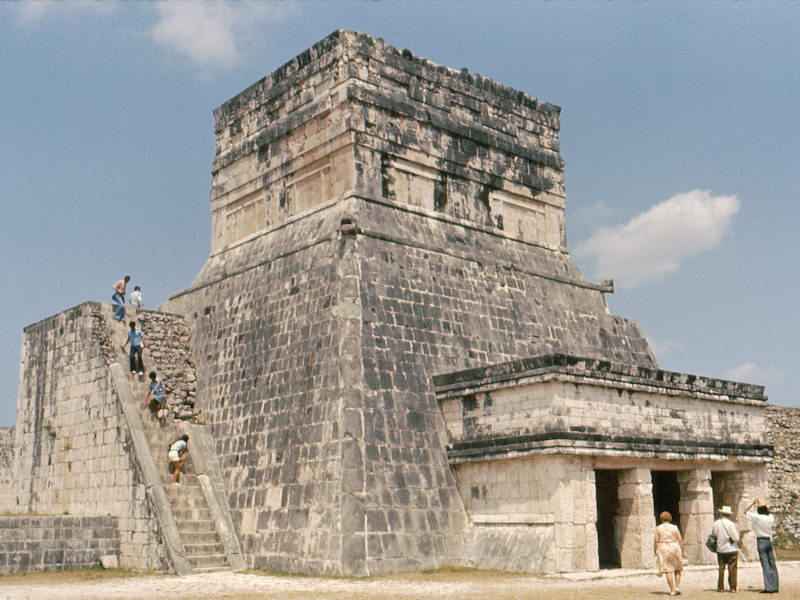Photo
album: "Mexico, Yucatán: Chichén Itzá (1)"
Fly
over a photo with the mouse to enlarge it
Click
on a photo to open it in a new window
On
Monday March 26th, 1973, we go on an excursion to visit the archaeological site
of Chichén Itzá. This site is situated at approximately 120 km east of
Mérida. Chichen means "the mouth of the well", Itzá is the name of
the tribe who lived in this place. The city was founded around 445 A.D. and
became one of the most important Mayan centres around 600. After a long period
of decay, between 645 and 905, it knew a new activity. Near 900 a Toltec king,
who bear the name of the god Quetzalcóatl, arrived from the central Mexico with
his army and, with the help of some local ally, made Chichén Itzá his capital.
The city was definitely abandoned around 1204. You find in this site an
interesting mixture of the Mayan and Toltec styles.
 |
We are now on the Great Ball Court. |
 |
Two teams participated in this game
whose goal was to throw a ball, made of latex, through one of the two
rings attached to the side walls of the court. The players could use any
part of their body to throw the ball, except their hands. It is thought
that, at the end of a contest, whose purpose was sacred, the players of
the defeated team were beheaded. |
 |
We find in this ballgame the
influence of the Toltec who were tribes of warriors.
A bas relief carving, on the walls of the Ball Court, shows players
decapitated, with streams of blood springing out of the wound. |
 |
In mixing with the Maya who were of
pacific nature, the Toltec created a new warrior class.
Bas relief carving, on the walls of the Ball Court. |
 |
The Temple of the Jaguars, situated at
the entrance of the Great Ball Court, is a totally Toltec style building. |
 |
Entrance of the Temple of the Jaguars. |
 |
A mural painting, inside the Temple
of the Jaguars, depicts a battle scene. |
 |
The Wall of the Skulls, this
monument is another testimonial of the warrior temperament of the Toltec. |
 |
The sacred Cénote, is the well
which gave its name at Chichén Itzá. It has a diameter of 65 metres, the
level of the water is 20 meters bellow the ground level, and the depth of
the water is 15 metres. Presence of water in those arid countries explains
the sacred character given to these wells and why inhabited centres
established nearby.
To appease Chaac, the god of the rain, offerings were thrown into the
Cénote. Sometimes those offerings were human sacrifices. |
 |
At the time of the Maya, the young
virgins who were to be thrown into the Cénote were often volunteers
because they thought they were to join the gods. After the arrival of the
Toltec, human sacrifices increased because prisoners of war were used as
offering.
Archaeological diving made in the Cénote permitted to remove thousands of
objects from the bottom of the Cénote, including human skeletons showing
traces of wounds well compatible with the sacrifice hypothesis. |
 |
At the other end of the sacbé(*)
which connects to the sacred Cénote, we perceive the Pyramid of Kukulkán,
called El Castillo (the Castle) by the former Spanish. Kukulkán is the
Mayan name of the Aztec god Quetzalcóatl (the plumed serpent).
(*) sacbé means white road because its stone paving was,
originally, coated with limestone stucco. |
 |
El Castillo is a step pyramid 24
metres high, plus 6 metres for the temple at its top. Its 55-metre sided
square base is oriented according to the cardinal points. The total number
of steps of its four stairways is 365 as the number of days in a year and
the number of its platforms is 9 that is half the number of months (18) in
a year of the Mayan calendar. |
 |
A tunnel, excavated in the years
1930, permits to get to a small temple at the top of another older pyramid,
over which the Pyramid of Kukulkán has been built.
We can see, on the photo, the entrance of this tunnel under the base of
the northern stairway. |
 |
Inside this hidden temple there is
a statue typical of the Mesoamerican pre-Columbian culture called Chac
Mool, that can be seen on the photo, and a jaguar shaped throne. |
 |
Stepping down the tunnel, from the
hidden temple. |
Go
back
.
.
.
.
.
.
.








